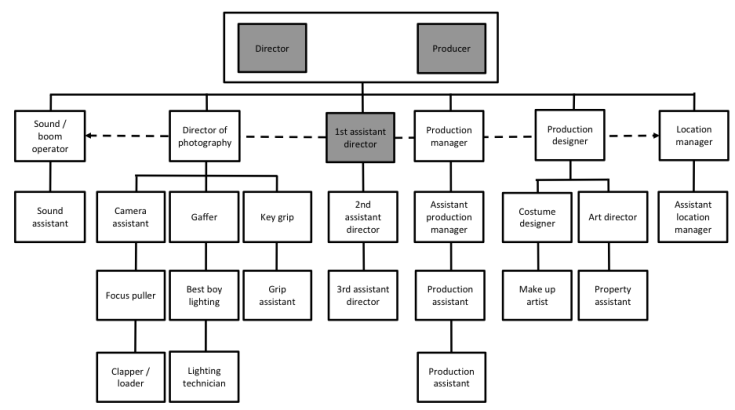By Joris Ebbers and Nachoem Wijnberg
Film projects have a dual-leadership structure, based on a division of tasks between the director and the producer, with the former predominantly responsible for the artistic and the latter for the commercial aspects of the film. The 1st Assistant Director (1st AD), who is positioned hierarchically below and between these dual leaders, plays an important role in managing conflicts between art and commerce.
A major characteristic of cultural industries is the tension between artistic and commercial objectives. To effectively deal with this tension, cultural organizations often have a dual leadership structure, in which each of the dual leaders have different responsibilities and objectives. Prior studies about dual leadership mostly focus on the dual leaders themselves. Instead, in our paper recently published in Human Relations, we do not just study the relation between the dual leaders themselves, but especially how their relation affects individuals below them in the organizational hierarchy, and how these individuals can alleviate dual leadership conflicts that can affect the organization as a whole.
The challenge of having a dual leadership structure is that conflicts between dual leaders can trickle down to lower levels of the organization. With regard to intra-organizational conflicts, one can make a distinction between task conflict and relationship conflict. Task conflict means there is disagreement among organizational members about what should be accomplished, while relationship conflict denotes interpersonal incompatibilities between the members expressed by tensions, hostility or annoyance. Although a mild degree of task conflict can have positive outcomes, because discussion and debate can lead to creativity and better decision-making, relationship conflict nearly always only has negative effects.
Task conflict is also related to the boundaries between organizational roles. This is especially important in dual leadership structures because task conflict between plural leaders, as well as between them and other members of the organization, can lead to role conflict and role ambiguity. Role conflict arises when individuals are faced with inconsistent or incompatible demands, while role ambiguity refers to uncertainty about which tasks and responsibilities are part of the role. Prior studies suggest that organizations should minimize role conflict and ambiguity because of its negative effects on performance. In this study, however, we explore how role conflict and ambiguity can also have positive effects because it forces organizational members to (re-)define their role, which, in turn, can lead to others in adjacent roles to subsequently redefine their roles, with positive effects on the organization.
A good example of a cultural industry with a dual leadership structure is the film industry. Film projects often have a dual leadership, with the director being mainly responsible for the artistic, and the producer for the business, aspects of the film. Because of its project-based nature, most roles in the film industry are highly standardized and clearly defined to ensure smooth collaboration between professionals that often do not have a collaboration history. The 1st Assistant Director (1st AD), who occupies a position hierarchically below the producer and director, is responsible for executing the planning, coordinating between the different departments, and in charge of the film set. Throughout the shoot the 1st AD is constantly communicating the intentions of the director to the rest of the cast and crew, while at the same time providing regular, often daily, progress reports to the production office. Figure 1 shows the organizational structure of a prototypical film set, highlighting key roles and reporting lines. The horizontal dashed lines originating from the 1st AD indicate the coordination task of the 1st AD with the heads of the other departments.
Figure 1: Key roles and reporting lines on a prototypical film set

The role of the 1st AD, precisely because they are accountable to both dual leaders, is characterized by role conflict and role ambiguity. First, they can experience role conflict because the expectations projected on them by the producer may be inconsistent, or even diametrically opposed, to those of the director. Second, they are likely to face role ambiguity because the boundaries of the 1st AD role, especially in relation to that of the producer and director, are unclear. However, role conflict and role ambiguity also provide 1st ADs with opportunities to define their role expansively. By doing so, 1st ADs can increase their ability to act as a buffer between the dual leaders. Moreover, the more the director and producer employ a narrow definition of their respective roles, the more space they leave for the 1st AD, and the more likely it is that positive effects ensue from the 1st AD facilitating collaboration between the dual leaders, and bridging the artistic and commercial sides of the organization.
Our study has a number of practical implications, the first of which is to suggest that organizations could profit from designing structures in such a way that it leaves space for lower-level organizational members, who can mediate between dual or multiple leaders by expanding their role, while taking into account how leaders can directly and indirectly facilitate such behavior. Second, because employees, also in non-project-based organizations, tend to have increasingly less stable, defined and demarcated roles, they have to be able to, or learn how to, proactively define their own roles. Finally, managers need to learn how to accommodate the positive aspects of role expansion while at the same time mitigating its potentially negative effects on organizational stability, especially as a result of discontent by those organizational members whose roles are being invaded.
This article is based on:
Ebbers, J. J., & Wijnberg, N. M. (2017). Betwixt and between: Role conflict, role ambiguity and role definition in project-based dual-leadership structures. Human Relations
About the authors:
Joris Ebbers is Associate Professor of Entrepreneurship and Innovation at the University of Amsterdam.
Nachoem Wijnberg is Professor of Cultural Entrepreneurship and Management at the University of Amsterdam.
About the image:
Film set (2006) Rue St-Laurent, Montreal. By Simon Law (CC-BY SA).

Leave a Reply